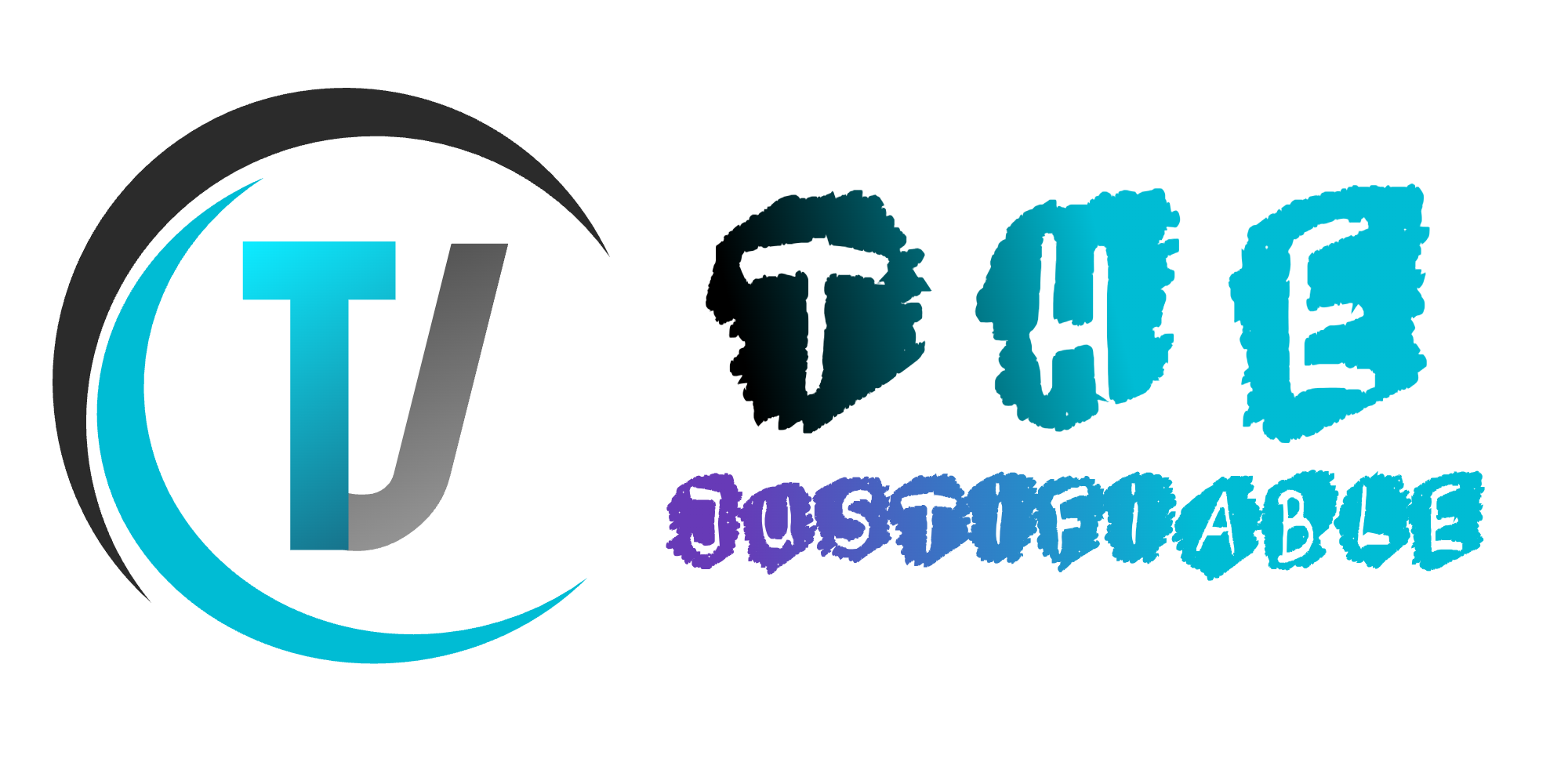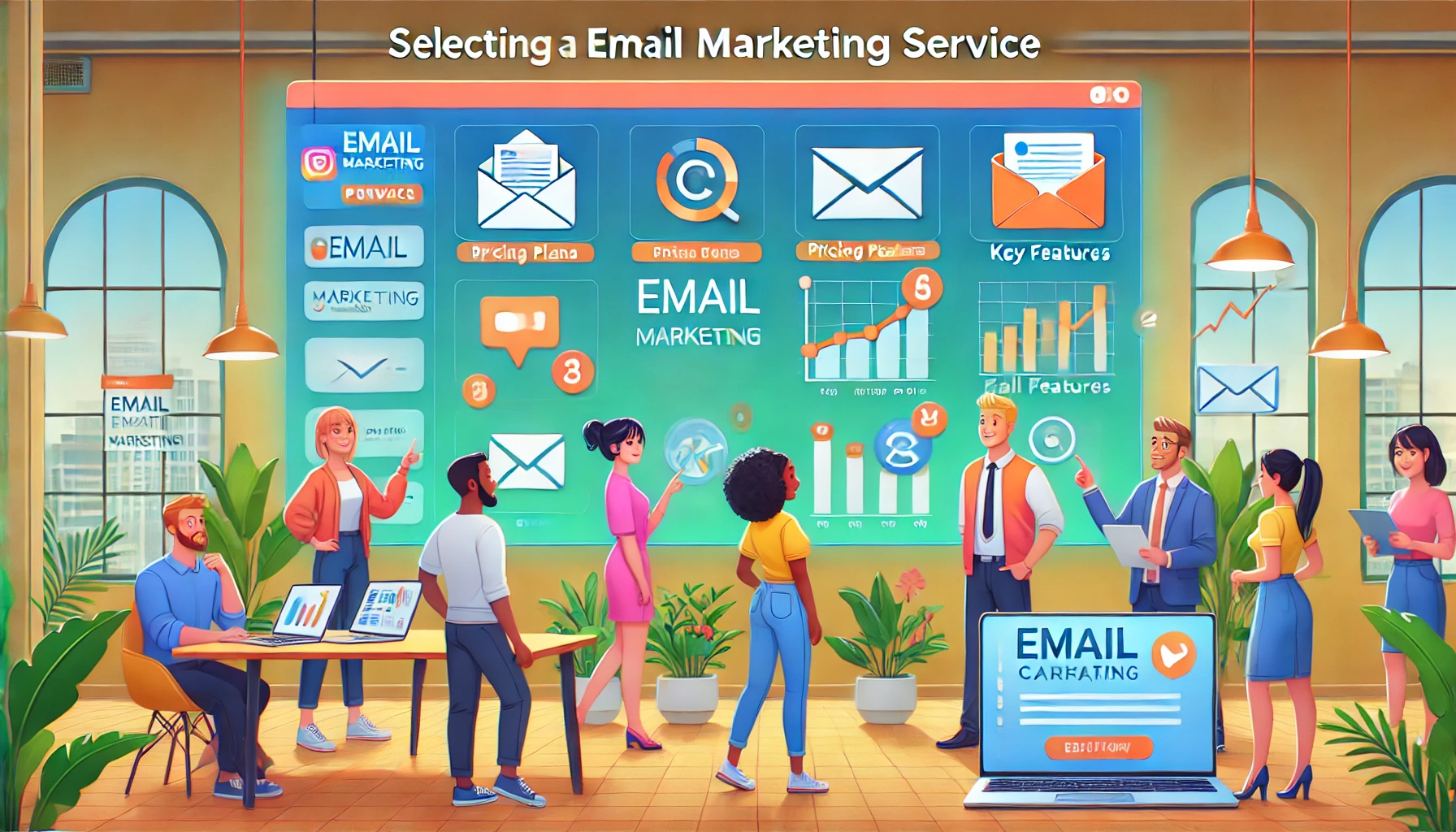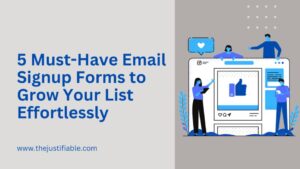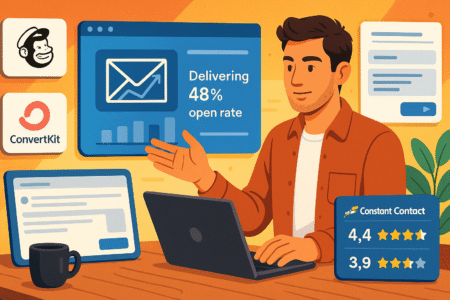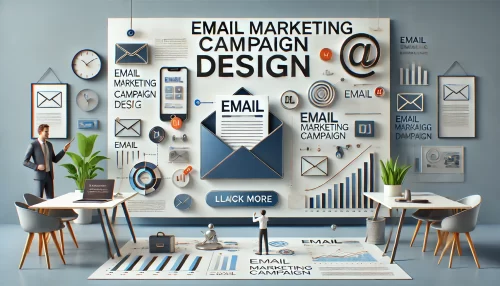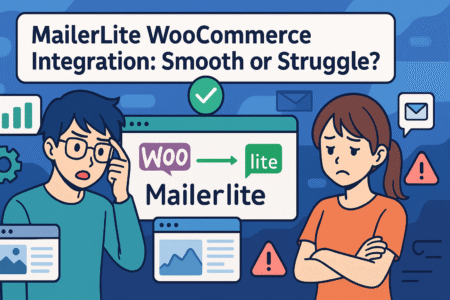Table of Contents
Looking for the best email marketing service to grow your business? With so many options available, how do you know which one offers the right features, affordability, and reliability? Should you go with a free plan or invest in a premium service? And which platforms provide the best automation, deliverability, and analytics?
In this guide, we’ve done the research for you. We’ll break down the top email marketing services, compare their features, and provide expert reviews to help you make the best choice. Whether you’re a small business, an ecommerce store, or an enterprise, we’ll walk you through the must-have features, common pitfalls to avoid, and emerging trends in email marketing.
Let’s dive in and find the perfect email marketing service for your needs!
What Is an Email Marketing Service?
An email marketing service is a platform that helps businesses create, send, and automate emails to engage their audience. Whether you’re nurturing leads, promoting products, or maintaining customer relationships, these services offer essential tools to streamline and optimize email campaigns.
With features like automation, segmentation, and analytics, they empower businesses to deliver personalized content and drive better engagement.
Key Features of an Email Marketing Service
A good email marketing service goes beyond just sending emails—it provides a robust set of tools to help businesses maximize their outreach. So, what should you look for when choosing a provider?
- Automation & Scheduling – The ability to set up drip campaigns, welcome sequences, and triggered emails based on user behavior can save time while improving engagement. Imagine setting up a welcome email that automatically greets new subscribers or a cart abandonment email that reminds customers to complete their purchase.
- Personalization & Segmentation – Not all subscribers are the same, and sending the same email to everyone won’t yield the best results. A great email marketing service allows segmentation based on demographics, purchase history, and user behavior, making your emails more relevant and effective.
- A/B Testing & Analytics – Ever wondered which subject line works best? A/B testing lets you compare different versions of an email to see what resonates most with your audience. Coupled with in-depth analytics, businesses can track open rates, click-through rates, and conversions to fine-tune their strategy.
- Drag-and-Drop Email Builder – Not a designer? No problem. Many email marketing platforms offer easy-to-use builders with pre-designed templates, so you can create professional emails without coding experience.
- Deliverability & Compliance – The best email marketing services ensure your emails land in inboxes—not spam folders. They also provide compliance tools to help you adhere to regulations like GDPR and CAN-SPAM, protecting both your business and your subscribers.
How Email Marketing Services Improve Campaigns
Investing in an email marketing service is about more than just convenience—it directly impacts campaign performance. But how exactly does it enhance your email marketing strategy?
For starters, automation eliminates manual work, allowing businesses to send timely and relevant emails without constant oversight. Instead of sending individual follow-ups, you can automate a series of emails that guide subscribers through a journey—from welcome emails to post-purchase follow-ups.
Then there’s personalization, which improves engagement. Generic emails often get ignored, but when emails are tailored based on customer behavior or preferences, they feel more relevant. For instance, an online clothing store can send a special discount for winter coats to customers who browsed that category.
Another key benefit is data-driven decision-making. With detailed analytics, businesses can see what’s working and what isn’t. Are your open rates low? Maybe your subject line needs work. Are people clicking but not converting? It might be time to refine your call-to-action. These insights allow continuous optimization, leading to better performance over time.
And let’s not forget cost-effectiveness. Unlike paid ads that require constant spending, email marketing delivers high ROI with minimal costs. Many services offer free plans for small businesses, making it accessible to those just starting out.
Types of Businesses That Benefit from Email Marketing
Is email marketing right for every business? While some industries rely on it more than others, nearly every business can benefit from a well-planned email strategy.
- Ecommerce Stores – Online retailers use email marketing to promote new arrivals, offer exclusive discounts, and recover abandoned carts. Imagine getting a friendly reminder about the pair of shoes you left in your cart, along with a 10% discount—hard to resist, right?
- Service-Based Businesses – Whether you’re a consultant, coach, or agency, email marketing helps maintain client relationships. Sending newsletters, appointment reminders, and special offers can keep your audience engaged and boost repeat business.
- SaaS & Tech Companies – Software businesses use email marketing for onboarding, product updates, and customer retention. A well-timed tutorial email can help new users understand features, reducing churn.
- B2B & Professional Services – Email is a powerful tool for nurturing leads in industries where sales cycles are longer. Whitepapers, case studies, and exclusive webinars sent via email can build trust and move potential clients through the sales funnel.
- Local Businesses & Brick-and-Mortar Stores – Just because your business operates offline doesn’t mean email marketing isn’t for you. Restaurants, gyms, and salons use emails to send promotions, loyalty rewards, and event invites, keeping customers engaged even when they’re not physically in-store.
💡 Pro Tip: If you’re just starting out, opt for an email marketing service that offers automation, segmentation, and analytics. These features will make your campaigns more effective and scalable as your business grows.
How to Choose the Best Email Marketing Service
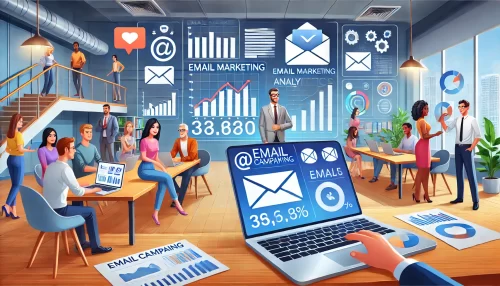
Finding the right email marketing service can feel overwhelming, with so many options available. The best choice depends on your business size, goals, and budget. Whether you need advanced automation, a simple email editor, or deep analytics, understanding key features and pricing differences will help you make an informed decision.
Essential Factors to Consider Before Choosing
Choosing the right email marketing service isn’t just about price—it’s about finding a tool that fits your business needs and helps you engage your audience effectively. Here’s what you should focus on before making a decision.
One of the biggest factors is ease of use. A complicated dashboard or clunky email builder can slow you down. If you’re spending more time figuring out the platform than actually creating campaigns, it’s probably not the right fit. Look for a service that offers an intuitive drag-and-drop editor, pre-designed templates, and clear navigation.
Next, think about automation capabilities. Not all email marketing services offer the same level of automation. Some only allow basic scheduled emails, while others let you set up complex workflows triggered by customer actions. If you plan to run automated campaigns like abandoned cart reminders or personalized follow-ups, automation should be a priority.
Deliverability rates matter more than you might think. Even the most well-designed emails won’t help if they land in spam folders. The best email marketing services have strong sender reputations, built-in spam compliance tools, and dedicated IP addresses to improve deliverability.
You also need to consider list management and segmentation. Sending mass emails to your entire list isn’t effective—targeting specific groups within your audience based on their interests, behavior, or past purchases leads to better results. Make sure the platform allows segmentation and easy list organization.
Lastly, integration with other tools can make your life easier. If your email marketing service connects with your CRM, ecommerce platform, or social media accounts, you’ll save time and streamline your marketing efforts. Look for services that offer seamless integrations with tools you already use.
Comparing Free vs. Paid Email Marketing Services
Many businesses start with free email marketing services before deciding whether to upgrade. While free plans can be a great way to test features, they often come with limitations. Understanding the trade-offs between free and paid plans can help you make the best choice.
Free email marketing services typically come with restrictions on the number of subscribers or emails you can send per month. For example, some platforms allow up to 2,000 subscribers and 10,000 emails per month, which may be enough for startups or small businesses. However, once your list grows, you may need to upgrade to avoid hitting these limits.
Another key difference is branding and customization. Many free plans require you to include their logo in your emails, which can make your messages look less professional. If brand consistency is important to you, a paid plan that allows full customization might be worth the investment.
Advanced automation and analytics are usually locked behind paid tiers. Free plans often lack features like A/B testing, advanced segmentation, or detailed reporting. If you’re serious about optimizing your campaigns and maximizing conversions, a paid plan gives you access to these powerful tools.
Security and compliance are another consideration. Some free plans don’t offer GDPR-compliant opt-in forms or advanced security measures, which can put your business at risk. Paid plans often include additional compliance tools to help you stay within legal guidelines.
If you’re just starting out and have a small list, a free plan might be a great way to get your feet wet. But if you’re running a growing business and need advanced features, a paid plan will likely be a better long-term investment.
Common Mistakes to Avoid When Selecting a Provider
With so many email marketing services available, it’s easy to make a choice that doesn’t fully align with your needs. Here are some common mistakes that can lead to frustration down the line.
One major mistake is focusing solely on price. While budget matters, the cheapest option isn’t always the best. If a low-cost provider lacks key features like automation, analytics, or good deliverability, it may cost you more in lost conversions and time spent troubleshooting issues.
Another mistake is ignoring scalability. A service that works for you now might not fit your needs a year from now. Some platforms charge significantly more as your subscriber list grows, so it’s important to check pricing structures and plan for future expansion.
Many businesses overlook customer support quality. If something goes wrong with your email campaigns, can you get help quickly? Some services offer 24/7 support with live chat, while others only provide email support with slow response times. Reading customer reviews can give you insight into how responsive a provider’s support team is.
Skipping deliverability research is another common pitfall. Some providers have poor sender reputations, which means your emails are more likely to end up in spam. Checking customer feedback and deliverability reports can save you from future headaches.
Lastly, failing to test before committing can lead to regret. Many email marketing services offer free trials or money-back guarantees—take advantage of these to see if the platform works well for your needs before making a long-term commitment.
💡 Pro Tip: Before committing to a provider, sign up for a free trial and test the platform’s usability, automation, and support quality. This ensures you choose a service that truly aligns with your business needs.
Related Articles:
- The Ultimate Guide to Using Templates for Email Marketing
- MailerLite WordPress Integration: Boost Email Marketing Now
- How to Run an Email Marketing Campaign That Converts
- How to Master AWeber Email Marketing in Just a Few Steps
- How Much Does An Email Marketing Campaign Cost
Best Email Marketing Services for Businesses
Choosing the right email marketing service is crucial for businesses looking to engage their audience, drive sales, and build lasting relationships. The best platform depends on factors like business size, automation needs, and integration capabilities.
Whether you’re a small business, an ecommerce store, or a large enterprise, finding the right provider can significantly impact your marketing success.
Top Email Marketing Services for Small Businesses
Small businesses need an email marketing service that’s affordable, easy to use, and equipped with essential features like automation, segmentation, and reporting. Many small business owners don’t have a dedicated marketing team, so simplicity and cost-effectiveness are top priorities.
Aweber is one of the most popular choices for small businesses. It offers a free plan for up to 500 subscribers, making it an excellent starting point for those with a tight budget. Its drag-and-drop email builder, pre-designed templates, and automation tools make it accessible even for beginners. Plus, it integrates with popular platforms like Shopify and WordPress.
Constant Contact is another strong contender, known for its user-friendly interface and excellent customer support. It provides a library of customizable templates, email automation, and list management features. One of its standout features is event marketing tools, making it ideal for businesses that host workshops, webinars, or in-person events.
For businesses looking for more automation, Brevo (formerly Sendinblue) is a solid option. It allows small businesses to set up automated workflows, send transactional emails, and segment their audience based on behavior. With SMS marketing and chat features included, it’s an all-in-one communication platform.
Affordability matters, but scalability is just as important. A good email marketing service should grow with your business, offering advanced features as your subscriber list expands.
Best Email Marketing Solutions for Ecommerce Stores
Ecommerce businesses need more than just basic email marketing—they require advanced automation, product recommendations, and seamless integration with online stores. Whether it’s abandoned cart emails, order confirmations, or post-purchase follow-ups, choosing the right platform can boost sales and customer retention.
Klaviyo stands out as a powerful ecommerce-focused email marketing service. Designed specifically for online stores, it integrates deeply with Shopify, WooCommerce, and BigCommerce. Its predictive analytics and AI-driven personalization help businesses send highly targeted emails based on customer behavior. If you want to recommend products based on past purchases, Klaviyo is a game-changer.
Omnisend is another excellent choice for ecommerce brands. It offers pre-built automation workflows for cart abandonment, product recommendations, and win-back campaigns. One of its biggest advantages is multi-channel marketing—it allows businesses to combine email, SMS, and push notifications in a single campaign.
For those looking for an affordable yet feature-rich solution, Drip is worth considering. It specializes in ecommerce automation, allowing businesses to create personalized experiences for their customers. With its deep segmentation tools, you can send emails based on purchase history, browsing behavior, and customer lifetime value.
Ecommerce businesses thrive on automation and personalization, making it essential to pick a service that offers both. A well-timed abandoned cart email or personalized product recommendation can make all the difference in boosting sales.
Enterprise-Level Email Marketing Services Worth Considering
Large businesses and enterprises require email marketing services with advanced features, scalability, and robust security. These platforms often come with AI-driven insights, custom reporting, and integrations with CRM systems.
HubSpot Email Marketing is a top-tier solution for enterprises. It’s part of HubSpot’s all-in-one marketing suite, offering powerful automation, A/B testing, and lead nurturing tools. The biggest advantage? It seamlessly connects with HubSpot’s CRM, allowing businesses to create highly targeted and personalized email campaigns.
Salesforce Marketing Cloud is another powerhouse in the enterprise space. Designed for businesses handling large-scale email campaigns, it provides AI-driven insights, advanced segmentation, and omnichannel marketing tools. Companies that already use Salesforce CRM will find this integration particularly beneficial.
For enterprises focused on high deliverability and transactional emails, SendGrid (owned by Twilio) is a top choice. It’s built for developers and marketers alike, offering APIs for seamless email delivery and automation features for personalized messaging. Major brands use SendGrid to send millions of emails daily while maintaining excellent deliverability rates.
Choosing an enterprise-level email marketing service comes down to scalability, automation depth, and integration capabilities. These platforms offer advanced solutions for businesses handling massive subscriber lists and complex marketing workflows.
💡 Pro Tip: Before committing to a platform, take advantage of free trials. Testing the user experience, automation tools, and integration capabilities firsthand will help you choose the best fit for your business.
Top Features to Look for in an Email Marketing Service
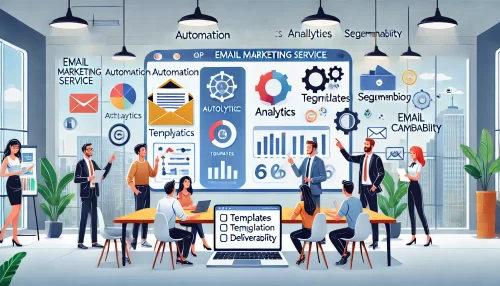
Not all email marketing services are created equal. While they all allow you to send emails, the real value lies in advanced features like automation, personalization, analytics, and deliverability. These tools can make or break your email campaigns, directly impacting engagement, conversions, and ROI. Understanding what to look for ensures you choose a platform that meets your business goals.
Email Automation and Workflow Capabilities
Automation is the backbone of an effective email marketing service. Instead of manually sending emails, businesses can set up workflows that trigger messages based on customer actions, saving time while improving engagement.
One of the most common uses of automation is welcome email sequences. When a new subscriber joins your list, an automated email series can introduce your brand, offer a discount, and guide them toward a purchase. Services like ActiveCampaign specialize in creating advanced automation sequences that adjust based on user behavior.
Abandoned cart emails are another powerful automation tool for ecommerce businesses. Platforms like Omnisend and Drip allow businesses to send reminders to customers who left items in their carts, often leading to higher conversion rates.
Lead nurturing is also significantly improved with automation. Instead of sending generic emails to your entire list, platforms like HubSpot enable businesses to send content tailored to where a lead is in the buying journey. If a customer downloads a free guide, the system can follow up with related content and offers.
Having robust automation and workflow capabilities means you can run marketing campaigns on autopilot while keeping them highly personalized. The right email marketing service should offer intuitive workflow builders, pre-built automation templates, and flexible triggers based on user actions.
Personalization and Segmentation Tools
Sending the same email to your entire list rarely delivers the best results. Personalization and segmentation tools help businesses create highly relevant content tailored to different audience groups.
Segmentation allows businesses to categorize subscribers based on factors like demographics, behavior, and past purchases. For example, a clothing brand using Mailchimp can send winter coat promotions to customers in colder regions while promoting summer wear to subscribers in warmer climates.
Beyond segmentation, true personalization involves dynamically inserting customer details into emails. Instead of starting with “Hello customer,” emails can use real names, reference past purchases, and even suggest products based on browsing history. Brevo (formerly Sendinblue) and Campaign Monitor excel in this area, offering deep customization options.
Another critical aspect of personalization is behavioral targeting. If a subscriber frequently clicks on certain product categories, an advanced email marketing service can automatically send related offers. Klaviyo is a leader in this space, using AI-driven insights to predict what customers will buy next.
Personalized emails generate higher engagement and conversions. Investing in an email marketing service with powerful segmentation and personalization tools ensures your messages are relevant, increasing the chances of a positive response.
A/B Testing and Analytics for Better Performance
Guesswork has no place in email marketing. A/B testing and analytics allow businesses to refine their strategies and optimize for better engagement.
A/B testing (also known as split testing) enables businesses to compare different versions of an email to see which performs better. Most email marketing services, including Constant Contact and ConvertKit, let users test elements like subject lines, call-to-action buttons, and email layouts. A well-executed A/B test can reveal small tweaks that make a big difference in open rates and conversions.
Beyond testing, analytics and reporting provide insights into campaign performance. Platforms like GetResponse and ActiveCampaign offer detailed metrics on open rates, click-through rates, conversion rates, and subscriber behavior. These insights help marketers understand what works and what needs improvement.
Some advanced services, like HubSpot Email Marketing, go a step further with predictive analytics. This feature uses machine learning to forecast how a campaign will perform based on past data. Businesses can then adjust their strategies before launching large-scale campaigns.
Without A/B testing and analytics, email marketing becomes a guessing game. The right tools provide clear data on audience preferences, enabling businesses to craft emails that drive real results.
Deliverability and Spam Protection Features
Even the best-crafted emails are useless if they never reach the inbox. Email deliverability determines whether messages land in inboxes or get flagged as spam. A high-quality email marketing service should have strong deliverability tools to maximize email success rates.
One of the key factors affecting deliverability is sender reputation. Platforms like SendGrid and Mailgun offer dedicated IP addresses, which improve email credibility and reduce the chances of being marked as spam.
Another important factor is compliance with anti-spam regulations. Many countries have strict email marketing laws like GDPR, CAN-SPAM, and CASL, requiring businesses to obtain consent before sending promotional emails. Services like AWeber and ConvertKit provide built-in compliance tools, including double opt-in forms and easy unsubscribe options.
Authentication protocols like SPF, DKIM, and DMARC also play a role in ensuring emails are recognized as legitimate. Some email marketing services, including Zoho Campaigns and MailerLite, include these authentication settings to enhance deliverability.
Another overlooked factor is list hygiene tools. Many providers, such as ActiveCampaign, automatically remove inactive subscribers or send re-engagement campaigns to boost sender reputation. A well-maintained email list improves overall deliverability and keeps engagement rates high.
Strong deliverability and spam protection features ensure that marketing emails actually reach the intended audience. Choosing an email marketing service with these tools safeguards campaigns against wasted efforts and lost conversions.
💡 Pro Tip: Before selecting an email marketing service, check its average deliverability rate and whether it supports authentication protocols like SPF, DKIM, and DMARC. Ensuring high deliverability prevents emails from ending up in spam folders.
Expert Reviews: Best Email Marketing Services
With so many email marketing services available, finding the right one can be overwhelming. Each platform offers different strengths, whether it’s affordability, ease of use, automation, or integrations. Based on expert analysis and real user experiences, here are the top services that stand out in key areas.
Best Overall Email Marketing Service
When it comes to an all-around email marketing service that balances features, usability, and value, HubSpot Email Marketing takes the top spot. It’s not just an email tool—it’s part of HubSpot’s full-fledged marketing suite, allowing businesses to manage email campaigns alongside CRM data, automation, and analytics.
One of HubSpot’s biggest advantages is its intuitive email builder. Even if you have no design experience, you can create professional emails using its drag-and-drop editor and customizable templates. This makes it accessible to beginners while offering advanced customization for experienced marketers.
Another reason HubSpot stands out is its deep automation capabilities. Businesses can create personalized email sequences based on user behavior, ensuring the right message reaches the right person at the right time. If a customer downloads a lead magnet, HubSpot can automatically send a follow-up email and nurture them through the sales funnel.
Deliverability is also a strong point. HubSpot maintains high sender reputation standards, ensuring your emails land in inboxes rather than spam folders. Its analytics dashboard provides detailed insights on open rates, click-through rates, and conversion tracking, making it easy to optimize campaigns.
For businesses looking for a powerful all-in-one platform, HubSpot Email Marketing is a top-tier choice.
Most Affordable Email Marketing Platform
For those on a tight budget, MailerLite is one of the most cost-effective email marketing services without compromising on essential features. It offers a generous free plan, allowing up to 1,000 subscribers and 12,000 emails per month—perfect for startups and small businesses.
Despite its affordability, MailerLite includes key features like automation, A/B testing, and a drag-and-drop editor. Unlike many budget-friendly services, it also provides a landing page builder, allowing businesses to create signup forms and lead capture pages without extra tools.
Another strong point is its simplicity. Many email marketing platforms can feel overwhelming, but MailerLite keeps things clean and user-friendly. If you’re new to email marketing and don’t want to deal with complicated workflows, this is an excellent option.
While the free plan is impressive, the paid plans are also affordable. For as little as $9/month, businesses can unlock unlimited emails, advanced segmentation, and priority support.
For businesses that need a budget-friendly but feature-rich email marketing solution, MailerLite delivers exceptional value.
Best Email Marketing Service for Advanced Automation
If automation is a priority, ActiveCampaign is the clear winner. It offers some of the most sophisticated email automation and workflow tools, making it ideal for businesses that want to create complex, behavior-driven email sequences.
ActiveCampaign’s automation builder allows businesses to create multi-step workflows triggered by user actions. For example, if a subscriber clicks on a link but doesn’t make a purchase, the system can automatically send a follow-up email with a discount. This kind of advanced targeting boosts engagement and conversions.
Another standout feature is conditional content. This means businesses can personalize emails in real-time based on subscriber data. If a user has previously purchased a certain product, ActiveCampaign can dynamically insert product recommendations based on their interests.
Beyond automation, ActiveCampaign excels in AI-powered analytics. It provides deep insights into customer behavior, predicting the best times to send emails and offering smart recommendations for improving campaign performance.
For businesses serious about automation and personalization, ActiveCampaign is the best choice for maximizing email marketing efficiency.
Most User-Friendly Email Marketing Software
If ease of use is your top priority, Constant Contact is one of the most beginner-friendly email marketing services available. Designed for small businesses and non-tech-savvy users, it provides a hassle-free experience without sacrificing essential features.
The standout feature of Constant Contact is its straightforward email editor. It offers an intuitive drag-and-drop interface with pre-built templates, making it easy to design emails that look professional. Even if you’ve never created an email campaign before, you can get started quickly.
Beyond basic email marketing, Constant Contact provides event marketing tools, which is a rare feature among competitors. Businesses can create and promote events, send invitations, and manage RSVPs—all within the platform.
Another reason Constant Contact stands out is its customer support. Unlike many competitors that rely solely on email support, Constant Contact offers phone support, live chat, and webinars to help users get the most out of the platform.
For businesses that want a simple, no-fuss email marketing solution, Constant Contact is a fantastic choice.
Best for Integrations With Other Tools
For businesses that rely on multiple marketing and sales tools, Brevo (formerly Sendinblue ) is the best email marketing service for integrations. It connects seamlessly with CRMs, ecommerce platforms, and customer support tools, making it a flexible choice for businesses that need everything to work together.
One of its strongest features is built-in SMS marketing. Unlike most email platforms, Brevo allows businesses to send text messages alongside email campaigns, providing an omnichannel marketing experience. If a customer ignores an email, an automated SMS follow-up can increase engagement.
Brevo also integrates with Shopify, BigCommerce, Salesforce, and over 50+ third-party apps. This makes it an excellent option for ecommerce businesses that want to sync customer data and automate email sequences based on real-time purchase behavior.
Another advantage is Brevo’s transactional email feature. Businesses that send order confirmations, shipping updates, and invoices can use Brevo to ensure reliable email delivery.
For those who need an email marketing service that integrates seamlessly with other business tools, Brevo is a top-tier choice.
💡 Pro Tip: Before choosing an email marketing service, test out free trials. This allows you to experience the platform’s usability, automation features, and support quality before making a long-term commitment.
Pros and Cons of Popular Email Marketing Services
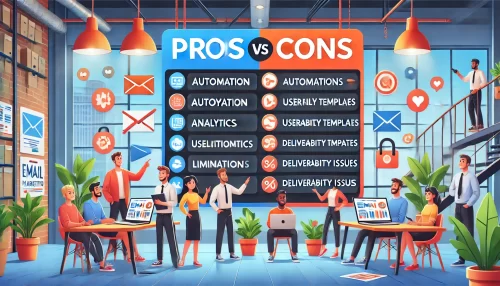
Choosing an email marketing service is about more than just features—it’s about weighing the strengths and weaknesses of different providers. While some platforms excel in automation and analytics, others stand out for affordability and ease of use. Understanding the pros and cons of top email marketing services helps businesses make informed decisions that align with their goals.
Strengths and Weaknesses of Leading Providers
Every email marketing service has unique advantages and drawbacks. What works for one business might not be the best fit for another. Let’s take a closer look at the strengths and weaknesses of some of the most popular providers.
HubSpot Email Marketing is a powerhouse for businesses that want an all-in-one marketing solution. Its biggest strength lies in its seamless integration with HubSpot’s CRM, making it easy to automate personalized email sequences. The platform also provides detailed analytics and AI-driven optimization. However, it comes at a higher price, which may not be ideal for small businesses with limited budgets.
Mailchimp is a popular choice for beginners and small businesses. It offers a free plan, user-friendly design tools, and built-in automation. However, its automation capabilities are limited compared to more advanced platforms, and pricing can escalate quickly as subscriber lists grow.
ActiveCampaign is known for its robust automation features, allowing businesses to create complex workflows based on customer behavior. It’s ideal for those who prioritize personalization and advanced segmentation. The downside? The learning curve is steep, and beginners might find it overwhelming.
Constant Contact shines in ease of use, offering a simple interface and excellent customer support. It’s great for small businesses that need basic email marketing tools without complexity. However, it lacks the depth of automation and integrations found in more advanced platforms.
Sendinblue (Brevo) is a strong choice for those who need a mix of email and SMS marketing. It provides affordable pricing and flexible automation tools. While it’s a great budget-friendly option, its reporting features aren’t as detailed as those of competitors like HubSpot or ActiveCampaign.
The best email marketing service depends on what a business values most—whether it’s automation, affordability, ease of use, or analytics.
Which Email Marketing Service Offers the Best ROI?
Return on investment (ROI) is one of the most important factors in choosing an email marketing service. A great platform should not only help businesses engage their audience but also generate revenue efficiently.
For businesses looking for high ROI with advanced automation, ActiveCampaign is a standout. Its ability to create behavior-based email sequences leads to higher conversion rates. While its monthly cost is slightly higher than some competitors, the return on personalized automation makes up for the investment.
If affordability and ROI are priorities, Mailchimp and MailerLite offer strong value. Both provide free plans and affordable paid tiers, making them excellent choices for startups and small businesses that need cost-effective email marketing solutions. While Mailchimp has more integrations, MailerLite offers slightly better automation at a lower price.
For ecommerce businesses, Klaviyo is one of the best investments. It integrates seamlessly with platforms like Shopify and WooCommerce, using AI-driven recommendations to increase sales. Though Klaviyo’s pricing is based on the number of subscribers, its data-driven automation helps generate higher revenue per email campaign.
Enterprise-level businesses often see the best ROI with HubSpot Email Marketing. While it requires a higher initial investment, the platform’s powerful CRM, automation, and lead-scoring tools create highly effective email marketing campaigns. The ability to track a lead’s journey from the first email to a completed sale makes it a strong choice for companies focused on long-term growth.
ROI isn’t just about cost—it’s about how well a platform helps businesses convert leads into paying customers. Choosing a service with strong automation, analytics, and personalization features often results in the highest return.
User Experience and Customer Support Insights
The usability of an email marketing service can make or break the experience, especially for businesses that don’t have dedicated marketing teams. Platforms with intuitive interfaces, drag-and-drop editors, and helpful onboarding resources save time and reduce frustration.
Constant Contact is one of the most user-friendly email marketing services, making it an excellent choice for beginners. The interface is clean, straightforward, and designed for non-technical users. The platform also offers phone support, a rarity in the email marketing space. While it may lack advanced automation, its ease of use makes it appealing for small businesses.
Brevo (formerly Sendinblue) is another great option for usability. Its automation workflows are easy to set up, and its visual campaign editor simplifies email creation. However, some users report that Brevo’s email templates are less customizable than those of competitors like Mailchimp.
For businesses that prioritize customer support, ActiveCampaign and HubSpot stand out. Both offer 24/7 chat and email support, along with extensive knowledge bases and training materials. HubSpot even provides dedicated account managers for higher-tier plans, ensuring businesses get personalized assistance.
On the other hand, Mailchimp’s customer support has received mixed reviews. While its interface is easy to navigate, users on free plans have limited access to support, which can be frustrating when troubleshooting issues. Paid plans offer better assistance, but some businesses prefer services with more accessible customer service.
Klaviyo, while powerful for ecommerce, has a steeper learning curve. Its in-depth analytics and segmentation tools require time to master, which may not be ideal for those new to email marketing. However, once users understand the platform, its capabilities are hard to beat.
A great email marketing service should not only offer powerful features but also make those features accessible. Platforms with strong user experiences and reliable customer support ensure businesses can effectively manage their email campaigns without unnecessary roadblocks.
💡 Pro Tip: Before committing to a provider, test its usability and customer support through a free trial. A platform that feels intuitive and offers strong support will make managing email campaigns much easier in the long run.
How to Get Started With an Email Marketing Service
Launching a successful email marketing service campaign requires more than just sending out messages—it involves careful planning, audience segmentation, and crafting compelling content. Whether you’re setting up your first campaign or optimizing existing strategies, following a structured approach ensures better engagement and results.
Step-by-Step Guide to Setting Up Your First Campaign
Starting an email marketing service campaign may seem overwhelming, but breaking it down into steps makes the process more manageable. Here’s how to get started.
The first step is to create an account and set up your email list. If you already have a list of subscribers, import them into your platform. Otherwise, begin collecting emails through sign-up forms, social media promotions, or incentives like free resources or exclusive discounts.
Once your list is ready, design your email campaign. Choose a format that matches your goals, whether it’s a promotional offer, a newsletter, or an automated welcome sequence. Keep the email layout clean and easy to read, with clear sections and engaging visuals.
Writing a compelling subject line is crucial—it determines whether your email gets opened or ignored. Keep it short, relevant, and intriguing to spark curiosity. A strong subject line should convey value or urgency without sounding overly salesy.
After finalizing your email content, set up automation and scheduling. Decide when and how often your emails should be sent, ensuring they align with subscriber engagement patterns. Timing plays a major role in open rates, so testing different send times can improve results.
Before sending, run tests to check for errors. Preview your email on both desktop and mobile devices, ensuring it looks professional and functions correctly. Send a test email to yourself or a small group to confirm that all links, images, and formatting are correct.
Following these steps ensures a smooth and professional campaign launch, increasing the likelihood of engagement and conversions.
How to Build and Segment Your Email List
A well-organized email marketing service list is essential for delivering the right messages to the right people. Without proper segmentation, emails may feel generic and irrelevant, leading to low engagement.
Building a strong list starts with ethical collection methods. Avoid purchasing email lists, as they often contain unengaged or uninterested recipients. Instead, encourage sign-ups through website forms, lead magnets, or exclusive content. Making the sign-up process simple and enticing increases the number of quality subscribers.
Once your list starts growing, segmentation becomes key. Rather than sending the same message to every subscriber, categorize your audience based on demographics, past behavior, or level of engagement. Segmentation allows for more personalized emails, which tend to generate higher open and click-through rates.
Behavior-based segmentation is particularly effective. For example, if a subscriber recently interacted with a specific topic, future emails can focus on related content. Similarly, if someone abandoned their shopping cart, sending a follow-up reminder with an incentive can encourage completion of the purchase.
Keeping your list clean and updated improves deliverability and engagement. Remove inactive subscribers regularly, and provide options for recipients to update their preferences instead of unsubscribing completely. A well-maintained list ensures your emails reach people who are genuinely interested in your content.
Best Practices for Writing High-Converting Emails
Creating engaging and persuasive emails is essential for maximizing conversions. Even with a well-segmented list, an email won’t perform well if the content doesn’t capture attention or inspire action.
Start with a compelling subject line that sparks curiosity or highlights value. It should be short and direct while encouraging the recipient to open the email. Personalization, such as using the recipient’s name or referencing their interests, often increases open rates.
Once inside the email, the opening line should hook the reader. Avoid generic introductions and get straight to the point. Whether it’s addressing a pain point, offering a solution, or sharing exciting news, the first sentence should immediately engage the reader.
The body of the email should be concise and visually appealing. Large blocks of text can overwhelm readers, so break up content into short paragraphs or sections. Using images, subheadings, or buttons can improve readability and make key points stand out.
Every email should include a clear and compelling call to action (CTA). Whether the goal is to encourage a purchase, drive traffic to a website, or promote a webinar, the CTA should be easily noticeable and action-oriented. Phrases like “Get Started,” “Claim Your Offer,” or “Learn More” work better than vague links.
Finally, ensure the email is optimized for mobile devices. Many people check emails on their phones, so formatting should be responsive, with easily clickable buttons and readable text. Testing across different devices ensures a seamless user experience.
💡 Pro Tip: Keep track of email performance metrics like open rates, click-through rates, and conversions. Analyzing data allows you to refine your strategy and improve future campaigns for better results.
Common Email Marketing Mistakes and How to Avoid Them
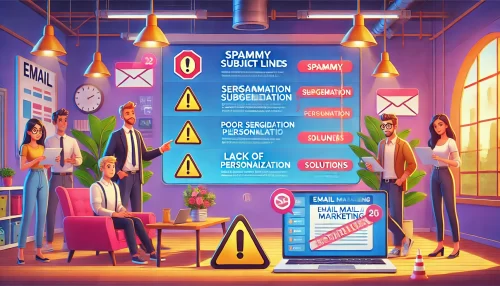
Even the best email marketing service can’t deliver results if common mistakes are holding your campaigns back. Whether it’s emails ending up in spam, excessive automation, or declining engagement rates, small errors can significantly impact effectiveness. Understanding these pitfalls and how to avoid them ensures long-term success.
Why Your Emails Might Be Landing in Spam
Few things are more frustrating than crafting the perfect email only for it to end up in a spam folder. If this keeps happening, it’s a sign that something in your approach needs adjusting.
A common issue is using spam-triggering words and phrases. Words like “free,” “guarantee,” or “urgent” can raise red flags with spam filters, especially when overused in subject lines. While some promotional language is unavoidable, keeping subject lines natural and focusing on value improves inbox placement.
Another culprit is poor sender reputation. Email providers track sender behavior, and if too many recipients mark your emails as spam, your domain’s reputation suffers. Ensuring that your subscribers genuinely opted in—and making it easy for them to unsubscribe—reduces complaints and protects your reputation.
Lack of authentication can also lead to emails getting flagged. Setting up SPF, DKIM, and DMARC records helps email providers verify that your messages are legitimate. Many email marketing services guide users through this process to improve deliverability.
Emailing unengaged or outdated lists increases the risk of spam complaints. Sending emails to inactive or irrelevant contacts signals to providers that your emails aren’t wanted. Regularly cleaning your list and removing inactive subscribers ensures that emails reach engaged users.
Formatting issues can also be a factor. Emails that contain too many images and too little text often trigger spam filters. A balanced text-to-image ratio, along with alt text for images, creates a more deliverable-friendly email.
Improving deliverability requires a mix of technical setup, thoughtful content creation, and ongoing list maintenance. Keeping emails relevant, authentic, and subscriber-focused minimizes spam risks and boosts engagement.
The Pitfalls of Over-Automation in Email Marketing
Automation is one of the most powerful features of an email marketing service, but too much of it can backfire. While automated workflows save time and enhance personalization, over-reliance on them can create a robotic and impersonal experience.
One common mistake is sending too many automated emails too quickly. If subscribers receive multiple emails in a short period—especially generic ones—they may feel overwhelmed and unsubscribe. Automation should feel natural, not like a relentless sales machine.
Another issue is failing to personalize automated sequences. While automation is meant to streamline communication, emails that feel too generic can come across as irrelevant. A welcome email that includes a subscriber’s name and references their sign-up source is far more engaging than a cookie-cutter message.
Overlooking behavioral triggers leads to irrelevant messaging. If someone already made a purchase but still receives an abandoned cart reminder, it signals poor automation logic. Ensuring workflows adjust based on real-time customer actions improves the user experience.
Automation should also be regularly monitored and adjusted. Some businesses set up email sequences and forget about them, leading to outdated messaging or broken workflows. Reviewing automated emails and analyzing engagement data ensures the content stays relevant.
Striking a balance between automation and human engagement is key. While automation helps scale marketing efforts, adding a personal touch—such as occasional manual outreach—makes a brand feel more authentic and customer-focused.
How to Maintain High Engagement Rates Over Time
Building an engaged email list is one thing—keeping subscribers interested long-term is another challenge. Engagement naturally declines over time if subscribers feel emails are repetitive, irrelevant, or too frequent. To keep open rates high and engagement strong, continuous optimization is essential.
One of the most effective tactics is regularly refreshing email content. Sending the same type of email repeatedly leads to fatigue. Mixing up content with educational newsletters, behind-the-scenes updates, exclusive offers, and interactive elements keeps subscribers engaged.
Segmenting your audience ensures that emails remain relevant. A one-size-fits-all approach often results in disengagement. If a subscriber is only interested in specific topics, tailoring emails to their preferences increases their likelihood of opening and interacting with messages.
Frequency plays a huge role in engagement. Sending too many emails can overwhelm subscribers, while sending too few can make them forget about your brand. Finding the right balance depends on audience preferences, which can be determined through testing and feedback.
Encouraging two-way engagement makes email marketing feel more interactive. Instead of always pushing messages, inviting subscribers to reply, participate in surveys, or share their opinions creates a more connected experience.
Monitoring key performance indicators (KPIs) helps identify what’s working and what needs improvement. If open rates are dropping, subject lines may need adjustments. If click-through rates are low, CTAs might not be compelling enough. Tracking data and adjusting strategies accordingly ensures ongoing success.
Email marketing is not a set-it-and-forget-it strategy. Keeping content fresh, personalizing outreach, and analyzing engagement trends ensures that subscribers remain interested and actively engaged with your emails.
💡 Pro Tip: Regularly test different subject lines, email formats, and sending schedules. Small tweaks based on performance data often lead to significant improvements in open rates and conversions.
Final Thoughts: Choosing the Right Email Marketing Service
Selecting the best email marketing service requires careful consideration of your business needs, budget, and long-term goals. The right platform should help you engage your audience, automate campaigns, and drive measurable results. Beyond choosing a provider, continuous optimization and strategic improvements ensure that your email marketing efforts remain effective.
Key Takeaways for Selecting the Best Service
Finding the right email marketing service isn’t just about features—it’s about choosing a platform that aligns with your specific objectives. Some businesses prioritize automation, while others focus on affordability or ease of use. Understanding your needs helps narrow down the options.
Ease of use is a major factor. A complicated interface slows down workflows and makes it harder to create compelling email campaigns. The best services offer intuitive dashboards, drag-and-drop editors, and customizable templates that simplify the process.
Deliverability is equally important. A powerful platform won’t help if emails consistently land in spam folders. Ensuring that the provider follows best practices for authentication, sender reputation, and compliance improves inbox placement.
Scalability matters for long-term success. While some businesses start small, growth often leads to more complex email marketing needs. A service that offers advanced automation, segmentation, and analytics ensures that the platform continues to meet evolving demands.
Support and integration options should also be considered. A provider with responsive customer service makes troubleshooting easier, while seamless integrations with CRMs, ecommerce platforms, and analytics tools help streamline workflows.
How to Continuously Improve Your Email Marketing Strategy
Choosing an email marketing service is just the first step. Ongoing refinement and data-driven adjustments are essential for maximizing engagement and conversions.
One key strategy is regular A/B testing. Testing different subject lines, call-to-action buttons, and email layouts provides valuable insights into what resonates with subscribers. Even small changes can lead to higher open and click-through rates.
Keeping content fresh is another critical factor. Sending repetitive or overly promotional emails can lead to disengagement. Balancing sales-driven messages with educational content, industry insights, and personalized recommendations keeps subscribers interested.
Segmenting the audience ensures that emails remain relevant. Subscribers have different preferences and behaviors, so sending personalized messages based on their actions improves engagement. Tracking which emails get the best responses helps refine targeting strategies.
Monitoring key performance metrics allows businesses to adjust their approach based on real data. Open rates, conversion rates, and unsubscribe trends provide insights into whether campaigns are effective or need adjustments. Regularly reviewing analytics ensures that email marketing remains a high-performing channel.
Engagement isn’t just about sending emails—it’s about fostering relationships. Encouraging replies, feedback, and two-way communication makes email marketing feel more interactive and valuable to subscribers.
Recommended Next Steps for Success
After selecting an email marketing service, taking the right steps ensures a strong start and long-term success. Here’s how to move forward with confidence.
Setting up email automation early on saves time while improving engagement. Whether it’s a welcome series, abandoned cart recovery, or re-engagement campaigns, automation helps nurture leads and build customer relationships without constant manual effort.
Consistently growing the email list ensures a steady influx of engaged subscribers. Using sign-up forms, lead magnets, and referral incentives expands the audience while maintaining quality contacts. Avoiding purchased lists protects deliverability and sender reputation.
Defining a clear email schedule prevents over-sending or long gaps between communications. Testing different frequencies helps determine the ideal balance that keeps subscribers engaged without overwhelming them.
Regularly analyzing email performance provides actionable insights for future improvements. Understanding what works—and what doesn’t—ensures that strategies evolve based on data rather than guesswork.
Optimizing email content over time strengthens results. Keeping emails concise, visually appealing, and action-oriented improves readability and encourages recipients to take the next step. Personalization, storytelling, and strategic calls to action enhance impact.

